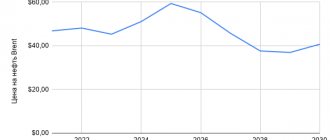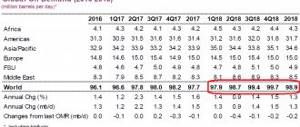Despite the development of alternative types of energy, petroleum products remain the most important resource on the planet. Hydrocarbon raw materials are used for the manufacture of motor and turbine fuels, lubricants, solvents, plastics, dyes, additives and other products.
Countries on all continents are engaged in oil production and refining. Exploration activities have shown where the most hydrocarbon-rich deposits are located. Let's talk about extracting valuable raw materials from the subsoil and present the ranking of countries by oil production.
EIA Weekly Report on US Crude and Refined Products Inventory Changes
The United States of America has its own independent statistical agency, the Energy Information Administration (EIA), which is responsible for collecting, analyzing and forecasting the reserves and production of oil, gas, coal and other energy sources (including nuclear). This information is displayed in the form of charts, tables, and graphs. The organization has existed since 1977, but its activities are constantly criticized for falsifying data upward. Weekly and annual EIA tabular reports for 2021 and 2021 can be viewed on their website.
Russia [11.540 million barrels per day]
If you ask a Russian about which countries produce the most oil, he will definitely mention the state in which he lives. Russia accounts for 12.1% of the world's daily oil production - this is not surprising, given that the country occupies 1/9 of the landmass on Earth.
But due to geographical difficulties, the Russian Federation has not yet been able to use all the reserves that are concentrated in the Far East, Eastern Siberia and the Arctic territories. According to general estimates, Russian oil reserves exceed 107 billion barrels, including Arctic sources.
UAE [3.998 million barrels per day]
The United Arab Emirates is a federation that includes seven territories (emirates). The most famous of them are Abu Dhabi and Dubai. They are located in the southern part of the Persian Gulf, a very rich oil region. The UAE's share in daily global production is about 4.2%. Reserves – 98 billion barrels. But 92 billion are in Abu Dhabi, which could cause international political problems. True, Abu Dhabi was previously generous with its neighboring cities and literally saved Dubai from financial problems in 2009. With current prices and production up to 4 million barrels per day, the UAE will be in an excellent position for many years.
World situation
Oil is the most important strategic resource that everyone needs. Exporters are in a more advantageous position; they dictate prices, and importers depend on them. Each country strives to acquire either its own large deposit or a reliable supplier who will provide them with everything they need.
The situation in the world is constantly changing. Until recently, England and Norway only imported oil and petroleum products, and only in the 1970s did they begin to export it to other countries. Many small states take advantage of their advantageous location, and if oil transits through their territory, they reduce their tariffs on raw materials.
The Middle East initially made large supplies, but under the pressure of American policy and sanctions it is now in a deplorable situation. But Saudi Arabia and the UAE, on the contrary, were able to emerge from severe pressure from America and become one of the leaders in oil exports.
Who are the main oil exporters now? They can be easily divided by the regions they occupy in the world:
- Asia is Saudi Arabia, UAE, Iraq, Iran, Qatar.
- Europe – Russia, Norway and Great Britain.
- America – this includes Mexico, Canada and Venezuela.
- Africa is Angola, Algeria and Nigeria.
We have collected original reviews on this topic here, reviews from real people, many comments, worth reading.
As you can see, the largest countries in the world are about a dozen, which is not as many as we would like. At the same time, the situation on the world stage is very changeable.
China [3.836 million barrels per day]
China is steadily increasing its pace. Over the past 50 years, it has extracted 4% of the world's total oil production every day. However, this is not enough for strong economic development and provision for a gigantic population. Like the United States, China consumes more than it produces, and China's reserves are modest - 26.2 billion barrels. But with the introduction of hydraulic fracturing and other technologies the country wants to use, reserves should increase in the future.
Rating of countries by oil production volumes
Despite the fact that deposits are becoming empty in some countries, these raw materials continue to play a leading role in influencing the global economy. We present the top 10 countries in terms of oil production, we will talk about the features of their economy, the cost of raw materials at the output and the impact of production on global processes.
In countries occupying leading positions, the cost of raw materials extracted from the subsoil may vary significantly. The difference of 4-5 dollars per barrel of oil is considered significant because:
- when the cost is high, income from profits falls;
- The lower the cost, the easier the extraction is technologically.
Anyone who follows the news has heard about shale oil at least once. This is a good example, since companies involved in its exploration cost the process on average 3 times more than those working with conventional raw materials.
Exporting shale hydrocarbons is not profitable if the average price per barrel is below 70-80 US dollars. We present a list of countries by oil production in the world.
10th place - Venezuela
The economy of this country is built on the extraction of black gold. In addition to revenues from oil exports, there is a clear disadvantage to this: 95% of revenues from foreign sales were the cause of the global crisis with falling prices for raw materials. It is noted that the inflation process was not stopped by the government, and today it amounted to 1,300,000%. The results are disappointing:
- citizens' incomes have fallen;
- a political crisis arose;
- Imported goods were in short supply and there was a threat of famine.
Hyperinflation rates in Venezuela
Problems arose in a state where the cost of hydrocarbon production is $30-45. The work is being carried out in the Orinoco basin, where heavy bitumen oil is concentrated. Venezuela is a member of OPEC, the organization controls almost 2/3 of its raw material reserves.
By
Saudi Arabia [11.832 million barrels per day]
The Kingdom of Saudi Arabia receives 12.4% of the planet's daily oil production. Based on the fact that the country “sits” on the oil throne with a reserve of 297 billion barrels, its position in the coming decades is beyond doubt.
True, the United States took the crown of the world championship in the energy industry in 2019. America has picked up serious momentum in the production of biofuels and natural gas, but this is not helping it overtake Saudi Arabia in terms of proven reserves.
When did they start extracting oil?
Oil has been known to mankind since ancient times. Back in 6000-4000 BC. it was used on the banks of the Euphrates as a binding material during the construction of Babylon. It was also used in Ancient Egypt for the mummification of pharaohs. In Ancient Greece, it began to be used as part of an incendiary mixture, as well as as fuel for sea lighthouses. Until the 18th century, oil was used unrefined. But already in 1733, the first information about its distillation appeared. In 1746, an oil refining plant was built on the Ukhta River. Such enterprises began to develop rapidly in 1857, when kerosene began to be extracted from oil. The first oil production from a drilled well took place in 1848.
People's Republic of China – 7th position
China is included in the ranking of countries that produce oil on a huge scale. This energy resource is found throughout its territory, mainly in the northeastern region and coastal zone. Since the 70s of the last century, China began its own production of petroleum products for its own needs and for export. But the republic did not lead in the export of “black gold” for long. It has long needed additional supplies of energy resources, which is associated with the rapid development of production.
In 2013, China discovered large hydrocarbon deposits on its territory. The Republic annually exports almost 0.2 billion tons of natural raw materials (4.6%).
Oil in China
Canada [5.651 million barrels per day]
The country of moose and maple leaves ranks sixth in the ranking of the most active oil producers. With a population of 37 million people (4 times less than in Russia), Canada accounts for 5.9% of the daily production of “black gold” in the world.
The situation is good in the long term. Most of the current reserves are in tar sands (a fossil fuel - a type of unconventional oil). As technology improves, Canada will benefit from these reserves, not to mention what may be discovered as sea ice declines in the Arctic. Now the country has 170 billion barrels in reserve – it is in third place in the world in terms of this indicator.
How many years will oil reserves last?
Scientists, when calculating the world's probable oil reserves, mean exactly those resources that are known with a 90% probability. And at the same time, those deposits that have not yet been discovered are not counted. Therefore, if we talk specifically about all the world's oil reserves, then we should add at least another 50%, or even all 90%, to the existing fields, from which active extraction of minerals is already underway.
At first, when geological exploration of a possible oil field is still underway, there is not enough information to assess the entire future scale of work. Often, the longer development takes place, the more reserves become proven rather than classified as probable.
For example, when oil was found in the Persian Gulf basin, at first it caused skepticism; scientists doubted the presence of large quantities of combustible material reserves. However, oil has been extracted there for more than 70 years, it does not disappear, which means that all the fears of the skeptics were in vain.
As for the development of so-called “heavy” oil reserves in Canada and Venezuela, profitability is in question. There are approximately 40 billion tons of probable reserves remaining.
Calculating probable oil reserves (that is, still undiscovered deposits), scientists, having carried out mathematical calculations, argue that it is more likely that there are at least 600 billion barrels worldwide (this is about 80 billion tons), with about 50 billion located in seas.
Thus, huge oil and gas deposits have been discovered in the seas of the Atlantic Ocean, in the southern Caribbean Sea and on the shelves of Venezuela. A large oil and gas region is located in the Bay of Biscay, off the Portuguese coast.
It is not easy to estimate promising reserves of unconventional oil, since the bulk of it is already accounted for in the reserves of Venezuela and Canada. In the world today, such deposits contain no more than 10 billion tons of proven reserves. Such deposits are located in the same well-studied basins as traditional oil. Therefore, apparently, the order of magnitude of undiscovered reserves in ultra-low-permeability reservoirs is in the first tens of billions of tons.
Probable and as yet undiscovered deposits account for approximately ½ of the proven reserves and do not significantly exceed the doubtful portion of proven oil production. Even with a skeptical view of things, one can assume that there are no less than 240 billion tons left in the world. Supporters of the optimistic forecast suggest that the number of estimated reserves is no less than 360 billion tons. This will be enough for 85-90 years.
Thus, probable oil reserves are quite sufficient to meet any possible public demand for this energy product. Scientists say that no crises are expected due to a lack of oil production. Presumably, the peak of oil development will occur in 2030-40, and this will be associated with turning points in the consumption of “black gold” in the world. The situation on the market, as always, will be determined by supply and demand, which in turn will regulate the exploration of new oil production sites, refining and transportation of the product throughout the world.
USA [17.045 million barrels per day]
The United States ranks first in terms of daily production in the world, occupying about 17.9% of the world. A stable investment climate and a high degree of technological development allow the country to introduce unconventional sources such as tar sands and shale.
US reserves are now estimated at 68.9 billion barrels, but consumption is higher than production. Therefore, the country imports a lot of raw materials from Mexico and Canada.
Read: 12 countries with the strongest economies in the world
The largest oil companies in the Russian Federation
All oil developments in Russia are in the hands of a few very large companies. Oil producers in the Russian Federation are the following:
- Rosneft;
- Gazprom;
- Tatneft;
- Lukoil;
- Bashneft;
- Russneft;
- Novatek;
- Slavneft.
All these companies have the right to conduct geological exploration, develop new fields, extract and refining oil, and can freely export it.
Largest oil fields
Deposits where oil reserves exceed 10 billion tons are considered gigantic. These include:
- Latin Chicontepec , located on the east coast of Mexico (22 billion tons).
- Al-Ghawar in the Persian Gulf basin (belongs to Saudi Arabia). Oil reserves there are 12 billion tons. They will be mined for decades to come.
- Kuwait's Greater Burgan , with 11 billion tons.
- The Carioca Sugar Loaf deposit in Brazil, where mineral deposits amount to 11 billion tons.
In addition, the largest oil fields are the Venezuelan Bolivar Shelf (8 billion tons), the Russian Samotlor field (6.2 billion tons), and the Kazakh Kashagan field (6.4 billion tons).
Al-Ghawar in the Persian Gulf basin
Kuwait [2.996 million barrels per day]
Kuwait's oil fields became the main prize for the country following the Gulf War (1990–1991). Today they make up 3.1% of total oil production. The first wells were launched in 1938.
According to a rough estimate, Kuwait has reserves of around 101.5 billion barrels, and the introduction of technology will increase this figure. At the current pace, the country can “pump” oil for another 100 years, guaranteeing its well-being.
Oil use
Oil is a valuable mineral resource on which the world economy depends. It is an oily flammable liquid containing hydrocarbon components. The color is not only black, but also green, maroon, yellow, and brown. “Black gold” contains more than 1000 different substances, but 90% of them are hydrocarbons. The remaining 10% includes oxygen, sulfur, nitrogen and very small inclusions of copper, magnesium, aluminum, and iron. Oil is highly flammable and does not dissolve in water. Due to these properties, it is mainly used to create fuels and lubricants (gasoline, fuel oil, kerosene, diesel fuel). But petroleum products are also used to produce plastic, rubber, petroleum jelly, polyethylene, polyvinyl chloride, medicines, cosmetics, synthetic fabrics, paraffin and even chewing gum.
A little about the terms
In order to avoid any confusion in the future, let's define the most basic concepts that we will use:
- An exporter is an entity or company that exports certain raw materials or goods from its country and sells it to foreign countries.
- An importer is an entity that purchases and imports foreign raw materials or goods into the territory of its state.
It is important to understand that when we talk about a subject, the conversation can also be about a company that exports or imports, and it can also mean an entire country. Of course, it is much more convenient to talk about states as a whole rather than singling out individual oil producing and refining companies.











